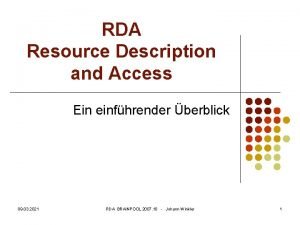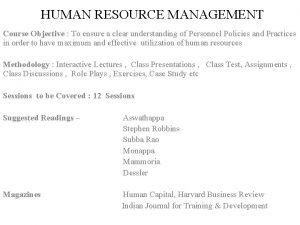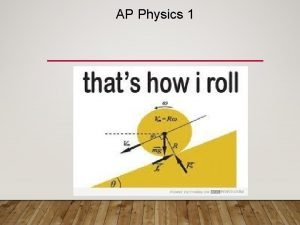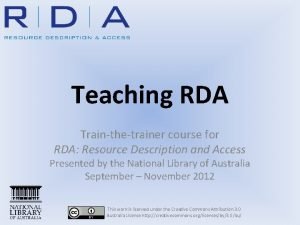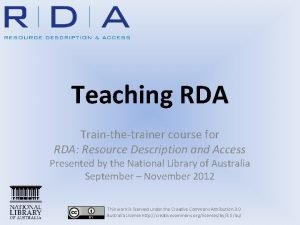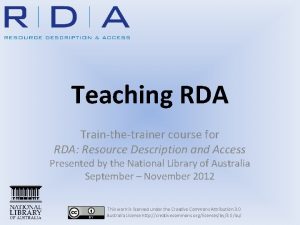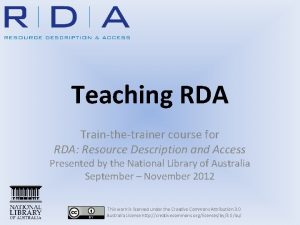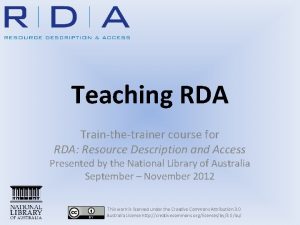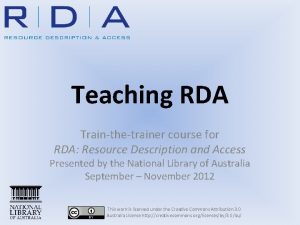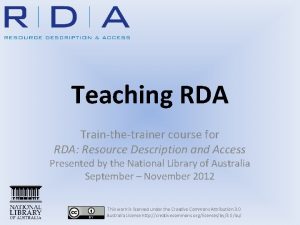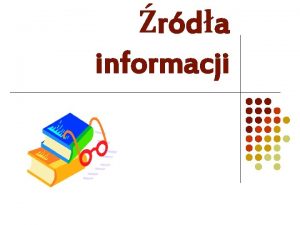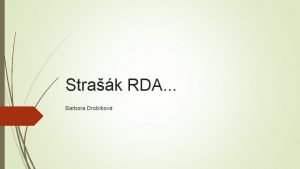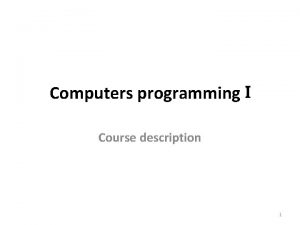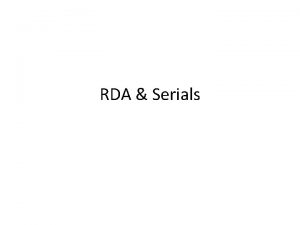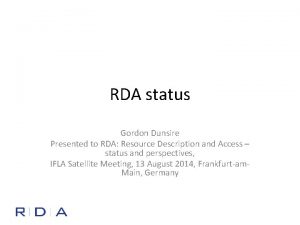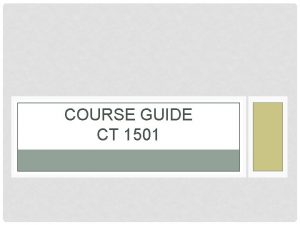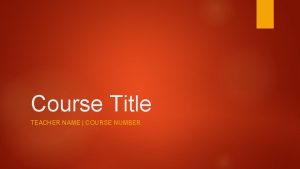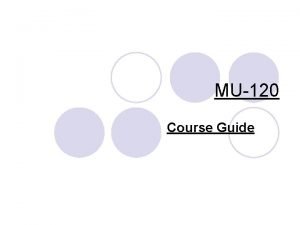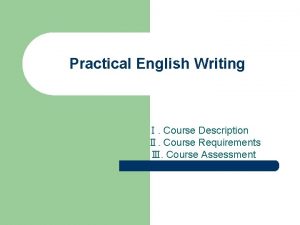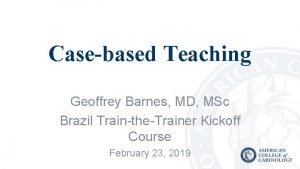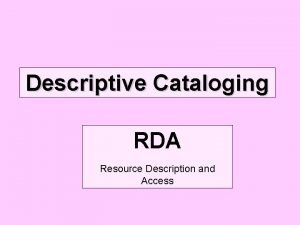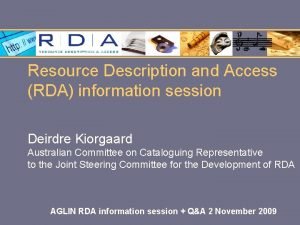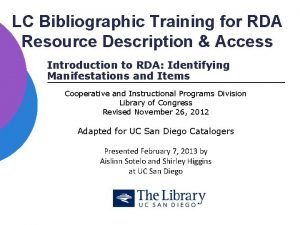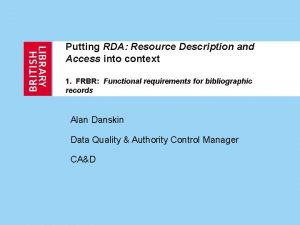Teaching RDA Trainthetrainer course for RDA Resource Description



















































- Slides: 51

Teaching RDA Train-the-trainer course for RDA: Resource Description and Access Presented by the National Library of Australia September – November 2012 This work is licensed under the Creative Commons Attribution 3. 0 Australia License http: //creativecommons. org/licenses/by/3. 0/au/

Module 7 Attributes of Works and Expressions RDA Section 2

Learning Outcomes • Understanding of Works and Expressions in the FRBR context • Describe content of Works and Expressions • Identify attributes of Works and Expressions • Construct Preferred Titles for Works and Expressions

Attributes of Works and Expressions Works Expressions Title (6. 2) Date (6. 10) Form (6. 3) Form of notation (7. 13) Date (6. 4) Content type (6. 9) Other distinguishing characteristic (6. 6) Language (7. 12) Intended audience (7. 7) Duration (7. 22) Context (6. 7) Illustrative content (7. 15) Nature of content (7. 2) Accessibility (7. 14) Summary of content (7. 10)

MARC bib record and FRBR Marc Field Work Expression Manifestation Item 1 XX/240 � � 245 -260, 490 � � 300 � � other 3 XX � � 5 XX � � 700 -730 � � 760 -787 � � 8 XX � �

Structure of Section 2 • General • Section 2 Specific – General guidelines • Chapters for groups of attributes • Chapters – Basic instructions • Specific instructions for each attribute – Basic instructions » Instructions for specific situations

Section 2, Chapter 5 • • Chapter 5: General instructions 5. 1 Terminology 5. 2 Functional objectives 5. 3 Core elements 5. 4 Language and script 5. 5 -5. 6 Access points NEW! 5. 7 Status of identification NEW! 5. 8 Source Consulted NEW! 5. 9 Cataloguer’s note NEW!

Exercise

Section 2, Chapter 5 5. 1 Terminology Key terms • Work and expression • Title • Access point

Section 2, Chapter 5 Title of Work only Title of expression • Add expression information to the title of the work • Different titles resulting from translations recorded as the title of the manifestation

Section 2, Chapter 5 Access points • Access point – name, term etc. , used to represent work or expression – Authorised access point – Variant access point [Access point for person, family, corporate body] Preferred title of the work

Section 2, Chapter 5 Access points Hemingway, Ernest, 1899– 1961. Sun also rises Barner (Family). Barner family newsletter Hamline University. Biennial catalogue of Hamline University

Section 2, Chapter 5 5. 3 Core elements • Core – identifying elements. • Two categories: – Core if needed to distinguish • Most content elements Non-Core • LC/NLA Core or Mandatory elements.

Section 2, Chapter 5 • Title 5. 4 Language and script – as on source of information • Other identifying attributes – As per each instruction • Descriptive elements (Ch 7) – As preferred by agency

Section 2, Chapter 5 5. 5 -5. 6 Access points NEW ! • 5. 5 Authorized Access Points Representing Works and Expressions • 5. 6 Variant Access Points Representing Works and Expressions

Section 2, Chapter 5 5. 7 – 5 -9 Authority record • 5. 7 Status of identification NEW ! – Level of authentication undertaken to verify access point • 5. 8 Source Consulted – Source of preferred title • 5. 9 Cataloguer’s note – Other information about access point

Section 2, Chapter 7: Describing content

Section 2, Chapter 7 Describing Content Screen image from the RDA Toolkit (www. rdatoolkit. org) used by permission of the Co-Publishers for RDA (American Library Association, Canadian Library Association, and CILIP: Chartered Institute of Library and Information Professionals)

Section 2, Chapter 7 • AACR 2 Notes Screen image from Cataloguer’s Desktop, Library of Congress • RDA Content Screen image from the RDA Toolkit (www. rdatoolkit. org) used by permission of the Co-Publishers for RDA (American Library Association, Canadian Library Association, and CILIP: Chartered Institute of Library and Information Professionals)

Section 2, Chapter 7 Sources of information • 7. 1. 1 Sources of Information -Usually taken from the resource -Further guidance under specific elements

Section 2, Chapter 7 7. 9 Thesis information 7. 9 Dissertation or Thesis Information 7. 9. 1 Basic instructions on recording Dissertation or Thesis Information 7. 9. 2 Academic Degree 7. 9. 3 Granting Institution or Facility 7. 9. 4 Year Degree Granted 502 ## $b. Ph. D $c. Australian National University $d 2012

Section 2, Chapter 7 7. 10 Summarisation of content • 7. 10 summarisation of Content s t c a r t s Ab Sum m Synopsis arie !NOT Contents notes! s

Section 2, Chapter 7 7. 11 Place and date of capture • 7. 11 Place and date of capture NEW ! Place and date associated with the capture (i. e. , recording, filming, etc. ) of the content of a resource

Section 2, Chapter 7 7. 12 Language Includes Subtitle s • 7. 12 Language - Language information in the descriptive elements - Language information in the access point for the expression is covered in Chapter 6.

Section 2, Chapter 7 7. 13 Form of notation N EW! • 7. 13 Form of notation Characters and/or symbols used to express the content of the resource Bra Љ c i l l i r y C Moon code Chess co de n a b a L y h p a r g o t e n i K ille co de t c i on a f l o s

Section 2, Chapter 7 7. 14 Accessibility content NEW • 7. 14 Accessibility Content ! -assists those with a sensory impairment in the greater understanding of content which their impairment prevents the fully seeing or n hearing. o i t p i r c s e d o i d u Ima A Cap t i o s l e ning ge d b a l escr iptio Sign language n

Section 2, Chapter 7 7. 15 Illustrative content • -content designed to illustrate the primary Portr content of a resource. a its Gra phs Music Illustrations facsimiles Phot ograp hs

Section 2, Chapter 7 7. 16 Supplementary content 7. 16 Supplementary • -content (e. g. , an index, a bibliography, an appendix) designed to supplement the primary content of a resource. I ncl ude s in filmography dex y h p a r g o i l b i B Discogr aphy

Section 2, Chapter 7 NEW ! 7. 28 Award • 7. 28 Award -formal recognition of excellence, etc. , for the content of a resource given by an award- or prize-granting body. t Austr s o m e i g o a L lian L r e v l i S I n f i y o brary t i l r a m e r a r tion A and Libra popula ssoc ry Te 0 1 0 2 , iation chnic program ian Awar Rese arch d, 20 12

Section 2, Chapter 7 Cartographic content • From AACR 2, MARC and Cartographic Materials manual • More detail than AACR 2. – Eg. Strings of co-ordinate pairs, right ascension and declination, equinox, epoch • Core elements: – 7. 25 Horizontal and vertical scale. – LC/NLA also Additional scale information.

Section 2, Chapter 6 Work Record Identifying works and expressions Titles of Works and Expressions Expression Record

Section 2, Chapter 6 Recording information Music Legal Titles of Works and Expressions Religious Treaties

Section 2, Chapter 6 Recording Attributes of Works and Expressions RDA 6. 1 - 6. 26 Recording information vs Constructing Access Points for Works and Expressions RDA 6. 27 - 6. 31

Section 2, Chapter 6 Identifying Works and Expressions 6. 2 – 6. 8 Identifying Works 6. 9 – 6. 13 Identifying Expressions 6. 14 – 6. 26 Identifying particular types of works Constructing Access Points Recording Attributes 6. 27– 6. 32 Constructing Access Points

Section 2, Chapter 6 Constructing access points Date not in access point

Section 2, Chapter 6 Quiz • What FRBR entities does chapter 6 deal with? • What types of materials have special instructions? • What two types of instructions can chapter 6 be divided? • What is the reason for these two types of instructions?

Section 2, Chapter 6 6. 2 Title of Work t n e m e l e e r o C 6. 2. 1 Recording titles 6. 2. 2 Prefer red tit le Title of the Work 6. 2. 3 e l t i t t Varian

Section 2, Chapter 6 e or C e m ele s t n 6. 7 History o f the Wor k 6. 3 – 6. 8 Distinguishing Titles 6. 8 Identif ier for t he W Title of the Work 6. 5 n i g i r o f o Place ork 6. 3 Form 6. 4 Date

Section 2, Chapter 6 6. 9 Content Type FRBR entity - Expression Content Type Categorisation reflecting the fundamental form of communication in which the content is Expressed and the human sense through which it is intended to be perceived. . .

Section 2, Chapter 6 6. 10 – 6. 13 Distinguishing Expressions 6. 10 n o i s s e r p x e n a ate of D 6. 11 age o f expr Langu Identifying Expressions Identi ession 6. 13 fier fo r an ex 6. 12 ishing u g n i t s i d s r c i e t h s i r Ot e t c a r a h c pressi on

Section 2, Chapter 6 Preferred Titles Examples 6. 2. 2. 4 Title of work Pride and prejudice 6. 3 Form of work Television program 6. 4 Date of work 1995

Section 2, Chapter 6 Preferred Titles Examples 6. 2. 2. 10. 3 Other compilations of two or more works: Record all work titles – Pride and prejudice Northanger Abbey Persuasion Emma Or Novels. Selections

Section 2, Chapter 6 Preferred Titles Examples 6. 2. 2 Preferred Title of Work German translation of Pride and prejudice titled Stolz und vorurteil Preferred title = Pride and prejudice

Section 2, Chapter 6 Exercise

Section 2, Chapter 6 6. 27 Constructing Access Points for Works and Expressions Austen, Jane, 1775 -1817. Pride and prejudice

Section 2, Chapter 6 6. 27. 1. 3 Collaborative Works Last chance to see By Douglas Adams & Mark Carwardine Adams, Douglas, 1952 -2001. Last chance to see

Section 2, Chapter 6 Compilations vs. Collaborations Compilation 6. 27. 1. 4 Collection of travel stories. . . Collaboration Vs 6. 27. 1. 3 Last chance to see by Douglas Adams & Mark Carwardine

Section 2, Chapter 6 6. 27. 1. 9 Additions Pride & prejudice (Motion picture : 2005) X-factor (Television program : 2012 : Australia) Bulletin (Australian Copyright Council)

Section 2, Chapter 6 6. 27. 2 - 6. 27. 4 • 6. 27. 2 Authorised Access Point Representing a Part of Parts of a Work • 6. 27. 3 Authorised Access Point Representing an Expression • 6. 27. 4 Variant Access Point Representing a Work or Expression

Section 2, Chapter 6 Exercise

Section 2 Summary • FRBR attributes Works and Expressions • Describing content of Works and Expressions from instructions in chapter 7 • Identifying attributes of Works and Expressions • Constructing authorised access points for Works and Expressions
 Resource allocation vs resource leveling
Resource allocation vs resource leveling Contoh resource loading
Contoh resource loading Resource description and access
Resource description and access Human resource management course objectives
Human resource management course objectives Ap world course and exam description
Ap world course and exam description Ap physics 1 course description
Ap physics 1 course description Soldier course vs sailor course
Soldier course vs sailor course Course number and title
Course number and title Course interne moyenne externe
Course interne moyenne externe Microteaching phases
Microteaching phases Kontinuitetshantering
Kontinuitetshantering Novell typiska drag
Novell typiska drag Nationell inriktning för artificiell intelligens
Nationell inriktning för artificiell intelligens Ekologiskt fotavtryck
Ekologiskt fotavtryck Varför kallas perioden 1918-1939 för mellankrigstiden?
Varför kallas perioden 1918-1939 för mellankrigstiden? En lathund för arbete med kontinuitetshantering
En lathund för arbete med kontinuitetshantering Särskild löneskatt för pensionskostnader
Särskild löneskatt för pensionskostnader Tidbok
Tidbok Anatomi organ reproduksi
Anatomi organ reproduksi Vad är densitet
Vad är densitet Datorkunskap för nybörjare
Datorkunskap för nybörjare Boverket ka
Boverket ka Debatt mall
Debatt mall Magnetsjukhus
Magnetsjukhus Nyckelkompetenser för livslångt lärande
Nyckelkompetenser för livslångt lärande Påbyggnader för flakfordon
Påbyggnader för flakfordon Formel för lufttryck
Formel för lufttryck Offentlig förvaltning
Offentlig förvaltning Jag har nigit för nymånens skära text
Jag har nigit för nymånens skära text Presentera för publik crossboss
Presentera för publik crossboss Jiddisch
Jiddisch Kanaans land
Kanaans land Klassificeringsstruktur för kommunala verksamheter
Klassificeringsstruktur för kommunala verksamheter Epiteltyper
Epiteltyper Bästa kameran för astrofoto
Bästa kameran för astrofoto Cks
Cks Byggprocessen steg för steg
Byggprocessen steg för steg Mat för unga idrottare
Mat för unga idrottare Verktyg för automatisering av utbetalningar
Verktyg för automatisering av utbetalningar Rutin för avvikelsehantering
Rutin för avvikelsehantering Smärtskolan kunskap för livet
Smärtskolan kunskap för livet Ministerstyre för och nackdelar
Ministerstyre för och nackdelar Tack för att ni har lyssnat
Tack för att ni har lyssnat Hur ser ett referat ut
Hur ser ett referat ut Redogör för vad psykologi är
Redogör för vad psykologi är Stål för stötfångarsystem
Stål för stötfångarsystem Atmosfr
Atmosfr Borra hål för knoppar
Borra hål för knoppar Vilken grundregel finns det för tronföljden i sverige?
Vilken grundregel finns det för tronföljden i sverige? Formel för standardavvikelse
Formel för standardavvikelse Tack för att ni har lyssnat
Tack för att ni har lyssnat Steg för steg rita
Steg för steg rita


